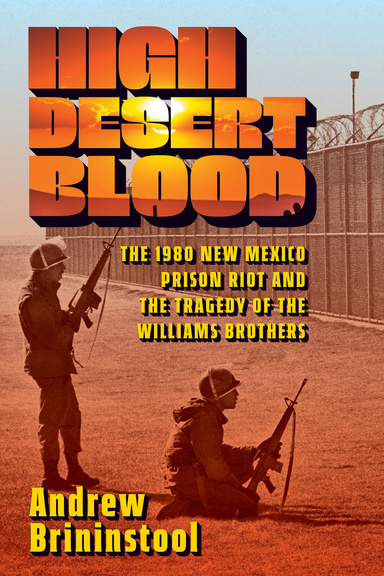
Each semester, the Writing University hosts the 5Q Interview series with authors from the University of Iowa Press. We sit down with UI Press authors to ask about their work, their process, their reading lists and events. Today we are speaking with Andrew Brininstool, the author of High Desert Blood (University of Iowa Press, 2025.)
Andrew Brininstool is a recipient of a National Endowment for the Arts fellowship in prose as well as a finalist for a PEN / Writing for Justice fellowship. His other work has appeared in the Southern Review, VICE, Millions, Tin House, and Best New American Voices. He was born in Santa Fe, New Mexico, and lives in Grapevine, Texas.
1. Can you tell us a little bit about your new book High Desert Blood?
High Desert Blood consists of two, interwoven threads: the first looks at the Penitentiary of New Mexico from its construction in the 1950s, when the facility was deemed the most modern and progressive on the planet, through its slow decay and, finally, how it became the setting of the country’s most violent prison riot. The second thread is more intimate, focusing on a handful of inmates—some victims, some not—and, in particular, the mysterious disappearances of two brothers incarcerated during the riot. It offers a gripping true crime journey through the heart of a system that failed its inmates, its staff, and the society it was meant to protect.
2. What was the inspiration for this work?
My grandmother was a Municipal Judge in Carlsbad, New Mexico. My aunt was a Chief Classification Officer at the men’s facility in Las Cruces. My mother has always been an avid reader—I recall her spending one summer reading Norman Mailer’s The Executioner’s Song.
As macabre as it may sound, I spent countless days listening to them discuss true crime, the criminal justice system—and the riot in particular: who they knew, what had happened, theories about why. As a child born in Santa Fe, the story of the riot always felt like familial lore—or, at the very least, a captivating part of the landscape.
Only later, when I casually referenced the riot to a colleague, did I realize how little the country knew about what happened in Santa Fe. Many have heard of Attica; few have heard of Old Main. I was encouraged to explore the topic—not only what took place, but how and why so few Americans are familiar with this part of our history.
3. Do you have any plans for readings or events for this book, either in person or virtual?
I do! I have a few lined up in Texas and New Mexico. More are in the works. I’ve also done a half-dozen podcast interviews thus far, with more scheduled. I’ll be sure to post these on my website / Substack (ABrininstool.com).
4. What are you reading right now? Any books from other university or independent presses?
I’ve really enjoyed other books from Iowa Press. Most recently, Cally Fiedorek’s novel Atta Boy has stayed with me. Harold Schechter’s writing is captivating. Sarah Anne Strickley’s Incendiary Devices from Tolsun Books is excellent. Everything Glenn Shaheen writes amazes me. Court Carney’s most recent book, Reckoning with the Devil: Nathan Bedford Forrest in Myth and Memory (LSU Press), is a must-read.
5. What is your writing routine? Do you have a daily routine?
I wish I had one. When I teach creative writing, I echo the advice of seasoned writers: get up before dawn, set a routine, don’t ever break it, show up every day. But I’ve found life to be a bit messier than that. I’ve trained myself to find time anywhere I can, to use it well, and to balance life with writing. I think there was a time when I believed life was writing. And it is. But life is also life. I would hate to resent one for the other.
**
BUY THE BOOK: High Desert Blood